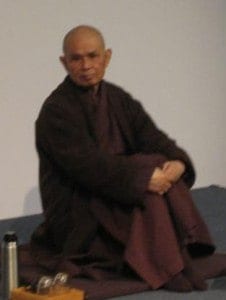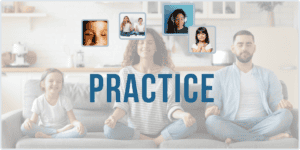Kid's Health
Seeds of Peace with Thich Nhat Hanh
Meditation for Kids and the Work of Thich Nhat Hanh
Thich Nhat Hanh passed away in January 2022, but I was fortunate to attend an educators’ retreat with him and his monastics in 2012 which led me to share ‘Seed of Peace with Thich Nhat Hanh’.
This blog describes a life-changing experience when I met the Zen Master of meditation.
At the time of this retreat, in the West, the focus had been on adults learning meditation. But this retreat for educators, therapists and professionals focused on helping them to share mindful skills with young people. At the time it was seen as pioneering. Fortunately, it is becoming more commonplace in homes and schools throughout the world.
I share my takeaways from that retreat – both personal and professional. And I intend to bring seeds of hope and peace to you and your children, along with practical steps and useful resources that may help you on your journey.
Seeds of Peace
The retreat attendees were (at first) focussed on learning specific techniques that could be implemented into their classes. The subject of challenging behaviour in young people was a key topic.
But the experience was so much more than knowledge or learning new skills. It became clear for many, that this retreat would offer the potential of a life-changing experience. Thay, and the Buddhist nuns and monks who work with him, introduced simple methods that all directed us to the same ‘North Star’ – to find peace within.
It became clear that to share this ‘North Star’ of peace could only happen if adults connected to their internal source of personal mindfulness, peace and joy first.
Perhaps you already know how much harder it is to bring peace into a classroom or a home if you are ateacher or parent who is feeling overwhelmed with work or personal stress? And perhaps you’ve observed how young people sense the stress of those others around them and then react to it?
To teach meditation and offer children peace, we first practice and connect to our own inner, resource.
Watering Our Seeds of Peace
I was fascinated to learn so much more on this retreat. I had practised meditation regularly for years and had become doubtful that I would learn something new. But I felt the significant benefits from the simple steps we were shown to access our inner peace. This involved:
- Mindful eating and noble silence
- Singing songs of mindfulness for children
- Body relaxation
- Mindful walking
The first Dharma talk that Thay gave was “Enjoying our Time Together”. He drew 3 circles.
The first circle was to represent the adult. The 2nd connected to family and the 3rd represented work. Through this he helped us understand how we must first take care of ourselves so that we are strong enough to support our family and then our work.
If I choose only to support family and work, I suffer.
I am the first step.
Throughout the retreat, we practised multiple mindfulness activities as listed above – and the effect on me was amazing.
Seed of Peace – Mindful Eating
At first, I found it really challenging to eat mindfully. The food was delivered in by self-service so mindful eating started from the moment I filled my plate.
I noticed that each day I found my proportions becoming smaller as I recognised the signals from my body telling me what I really needed and when I was full.
We would sit down at tables with both the nuns, monks and other retreat attendees. Initially I felt embarrassed sitting at a table with strangers yet not talking to each other as we practised mindful eating in silence. I used my awareness to acknowledge this feeling and accept it as I kept returning to the food I was eating.
I found that I was grasping my knife and fork whilst chewing, so I chose to lay them down until I finished a mouthful. Then I noticed how the food felt in my mouth – the different flavours of watercress and the moisture of cucumber.
In addition to smaller proportions of food, I started to enjoy eating mindfully. I found myself taking a moment to observe my food before I started eating just to be curious about what was on my plate. The different colours, shapes, textures – it was beautiful.
As I ate, I would think about all the energy that created this food. The energy of the elements: the sun, rain, wind and earth that helped it to grow. I was curious about the energy of those who had harvested this food and prepared it from there to my plate.
On the last day, I sat at breakfast and with my hands in Namaste (prayer position), eyes closed and feeling gratitude for the food I had to eat. My eyes filled with tears, and a beautiful rush of energy flowed through me. I felt blessed and a deep sense of peace to be in that moment, taking care of myself.
Mindful eating with Children
After this experience, I recognised how adults worry about what and how much children eat. It can bring stress to a family meal or school dinner time that could offer a different experience if we took the time to give children the choice of mindful eating.
Instead of trying to rush children through their food (as we worry about boredom, food going cold, quantities they eat) – perhaps we could tap into children’s inner Zen Master?
We could introduce the opportunity for them to practice some mindfulness before eating. Here are a few practical suggestions.
If you can’t do this ever day, try to aim for once a week and build from there.
Home practice
- Involve them in the preparation of food. Mindfully chat about the energy that was used to create this food, the smell and sound as it cooks.
- As they lay the table, invited a mindful chat about different textures and flavours and why they enjoy these and how it makes their bodies feel?
- Focus in on the sense of touch, smell and sound as they lay the table – wiping it clean, laying forks and knives down.
- If you are having meat at dinner, invite them to feel gratitude by saying ‘thank you’ to the animal that gave its life so they could eat and be healthy.
- Invite them to be curious about how the food on the plate looks – the colours and shapes and how it is arranged.
- When they take a mindful, invite them to close their eyes and listen, feel the food they are eating and notice what happens.
- And essentially, you practice alongside them and be curious about watering your personal inner seed of peace expanding with every mindful moment as you eat together.
Mindful Eating: Food Contemplations
(An excerpt from the book ‘Planting the Seeds’ – Practicing Mindfulness with Children)
- This food is the gift of the whole universe: The earth, the sky, the rain, and the sun.
- We thank the people who have made this food, especially the farmers, the people at the market and the cooks.
- We only put on our plate as much food as we can eat.
- We want to chew the food slowly so that we can enjoy it.
- This food gives us energy to practice being more loving and understanding.
- We eat this food in order to be healthy and happy, and to love each other as a family.
School lunchtime – Mindful Eating Practice
If you would like to learn more about mindful eating practices for schools, please connect with us (below) and we’ll share a mindful eating practice that can be incorporated into school lunchtimes.
We’ll be releasing more information in our next blog post about the different techniques shared on this retreat. Please subscribe to our mailing list or follow us on social media to be kept informed.
If you wish to learn more about helping children learn meditation please check out our Connected Kids Program.
Learn to teach children meditation
Practise meditations support







